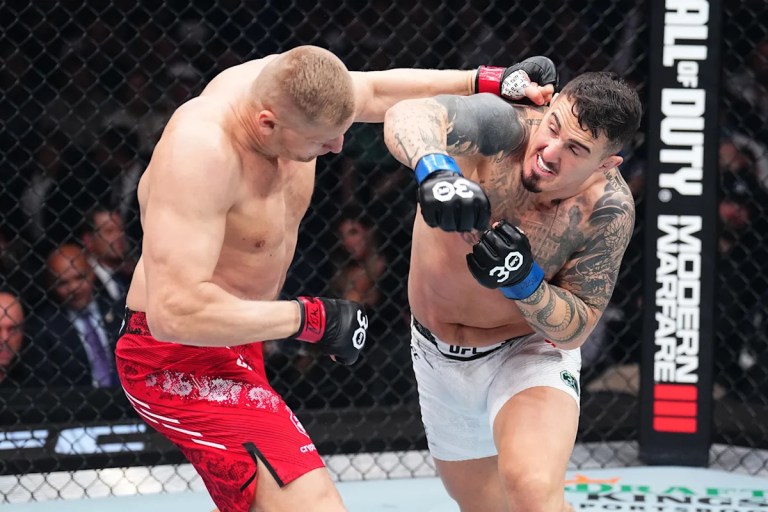NEW YORK — This was a fourth-round match with unusually large consequences, a highly charged litmus test, a gut-check in real time.
After missing the entire 2023 season on maternity leave, four-time Grand Slam champion Naomi Osaka has expressed frustration with her lack of progress. When would her game regain that ethereal major-winning quality?
Coco Gauff, even in the wake of a title at Roland Garros, turned to biomechanics specialist Gavin MacMillan just before the US Open, willing to sacrifice short-term results by playing the long game. Could she rely on her great strengths of speed and competitive fire while making significant adjustments to her serve and forehand?
The answers arrived in only 64 minutes on Monday in Arthur Ashe Stadium as Osaka dropped a decisive 6-3, 6-1 decision on Gauff to advance to the quarterfinals. It’s Osaka’s first major quarterfinal since winning the 2021 Australian Open.
It was reminiscent of the memorable match between the two here six years ago. Osaka, at the height of her powers, dispatched a 15-year-old Gauff 6-3, 6-0 in a third-round match that ended with tears. The difference is that Gauff was seeded No. 3 here and Osaka was No. 23.
“I mean I’m a little sensitive — I don’t want to cry,” Osaka said afterward. “Honestly I had so much fun out here.
“This is my favorite court in the world, and it means so much to be back here.”
Much has been made of Osaka’s move to coach Tomasz Wiktorowski. And while Iga Swiatek’s former coach has been a boon to her confidence, the difference between the 2024 Osaka and this year’s edition might just be fitness — and the confidence that brings.
“I think physically in my head I know that I’m capable of rallying a lot, so I don’t overplay,” Osaka said afterward. “I kind of am OK with just waiting. Granted, I’m not a defensive player, so it’s not like I’m trying to move side-to-side, but it’s more like the silent confidence of understanding that I don’t need to hit a winner at all times.”
Even earlier this year, she appeared sluggish at times, impatient to end points quickly. Against Gauff, Osaka moved exceptionally well, weathered long rallies and stayed in a visibly positive frame of mind. Her intensity was palpable.
So was her patience. Osaka won 16 of the 24 rallies that went five shots or more. She also converted each of the four break points she earned. Osaka next plays Karolina Muchova, a three-set winner against Marta Kostyuk.
Gauff, meanwhile, consistently struggled with her forehand and service game. There were five double faults, but the forehand was the real issue. Gauff had 20 unforced errors on that side. On this occasion, even her usually reliable backhand sometimes broke down.
Even early on, Gauff’s forehand was fluky (five errors) and Osaka broke and then held at love for a 2-0 lead.
But while Gauff — with a tweaked toss — had eased into her service games in the opening rounds, she came out firing against Osaka. She stroked two aces in her second service game and the other two first serves were unreturned. They were all 110 mph-plus.
That break was the only margin until Gauff, trailing 5-3, was broken again. Two double faults, in addition to two groundstroke errors, gave Osaka the set in 31 minutes.
With the match on serve at 3-2 in the second set, Gauff served into trouble. A double fault started it and an errant backhand closed it as Osaka converted her third break point in her third try.
Osaka scored one last break to secure the match.
“I thought that was a good performance from me serving,” Gauff told reporters afterward. “Off the ground I think I just made way too many mistakes, way too many errors, which I feel like that’s the part of my game that I felt the most confident in coming into the tournament.
“It’s disappointing. For sure it was not the level that I wanted to bring, but it is a step in the right direction I feel, and I think emotionally how much this week was, I think today I just stepped in, and I maybe was a little bit empty.”
Osaka is realistically trying to win her third US Open title in eight years. This is her fifth trip to the quarterfinals of a Grand Slam. It’s worth noting that she won the first four.
The turning point, Osaka said, came last month in Montreal.
That was when Osaka came back from down a set and 5-3, saving two match points, to defeat No. 13 seed Liudmila Samsonova in a match that went more than two-and a-half hours.
“I was really frustrated for a long time,” Osaka said, “because I felt like I was playing well, but there was just something that I don’t know if I was missing or it was just a mentality thing. Then I played Samsonova, and I didn’t give up until the very last point.
“I think from that moment on I just tried to be the biggest fighter that I can be.”





